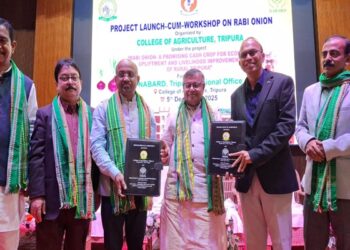Agartala, January 14:
Tripura is gearing up for the Poush Sankranti celebration on Monday with fervor. In bordering Lankamura village, also getting popular as ‘Alpana Gram’ women engage in the age-old tradition of crafting rangolis called alpans to beautify their homes and courtyards.
These intricate designs, made from various leaves and mud, hold cultural significance as they welcome goddess Lakshmi with good fortune and prosperity.
For around 15 days leading up to the celebration, locals prepare for Poush Sankranti by creating different colors from leaves and mud.
Additionally, they make rice powder from newly harvested paddy, using it to craft rice cakes and sweet dishes offered to the gods.
This culinary tradition has been passed down through generations, with women learning from their ancestors and passing it on to the next generation.
The festivities also include worshipping the Sun god and offering dishes made from the new paddy.
The symbolic patterns created during this time symbolize religious beliefs, with the hope of inviting prosperity, health, and wealth into their homes.
While the tradition remains strong in rural areas, the hustle and bustle of city life have led to its decline. Nevertheless, in rural settings, Poush Sankranti is a highly auspicious celebration marked by devotion and grandeur.
People engage in various rituals, including burning thatched houses in the wee hours, singing religious hymns, and praying for their forefathers.
As part of the celebration, women in the rural areas make rice flour in traditional ways from the winter harvest, creating rice cakes to welcome relatives.
Poush Sankranti holds cultural and religious significance, with various sweet dishes prepared using the new harvest paddy and offerings made to gods and forefathers.
The Hindu festival of Makar Sankranti, which coincides with Poush Sankranti, marks the transition of the sun into Capricorn. This event signals the beginning of Uttarayana, a six-month period considered auspicious for spiritual pursuits.
Additionally, Makar Sankranti signifies the gradual end of winter, with days becoming longer and warmer after the winter solstice in the northern hemisphere.








































